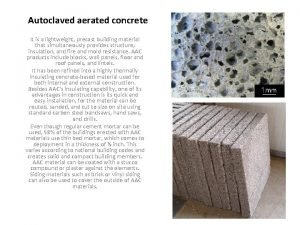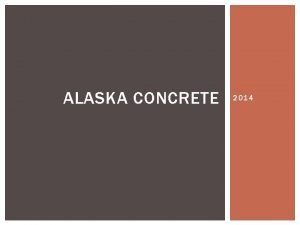Extremity Injuries in Precast Concrete Manufacturing Extremity Injuries







- Slides: 7


Extremity Injuries in Precast Concrete Manufacturing • Extremity Injuries account for about two-thirds of all reportable incidents in precast concrete manufacturing. - These injuries have multiple hazard sources including: • Concrete Products • Reinforcement • Cranes • Conveyors • Welding • Nails • Falls • Slips • Forklifts • Lumber • Machinery • Concrete Mixers • Forms • Flame/Fire Since these injuries happen in such a broad spectrum there is no one answer solution.

How to Address the Incident Types Awareness training, toolbox talks, and safety briefings involving these topics are good starts: • Pinch points. • Industrial awareness. • Handling of reinforcement. • Housekeeping. • PPE. Warning labels, decals, posters, and banners also aid in keeping workers mindful of dangers.

Job Hazard Analysis (JHA) Job Hazard Analysis – Technique that focuses on job tasks to identify hazards before they occur. It focuses on the relationship between worker, task, tools and the work environment. Job Hazard Analysis can be conducted with the focus on extremity hazards: • Watch each process to see where there is danger of extremity injury. • Document all hazards. • Propose possible controls following the NIOSH hierarchy of controls.

Hierarchy of Controls The National Institute for Occupational Safety and Health (NIOSH) created the hierarchy of safety control to help remove and reduce hazards. Controls are listed in the order NIOSH recommends implementing them: • Elimination – Completely removing the hazard altogether. • Substitution – Replacing the hazard with something that will not cause possible injury (replacing a caustic chemical with one that doesn’t cause burns). • Engineering – Create barriers preventing the hazardous energy exchange (finger guards). • Administrative – Changing the way things are done (new best practices). • PPE – Personal protective equipment is used to guard against injury (gloves).

Monitoring and Using Data to Prevent and Control Hazards Lagging indicators are used to measure incidents in the form of past accident statistics. Lagging indicators can be used to identify hazards and implement controls. • OSHA 300 Logs will provide data on past incidents which allows companies to see patterns and recurrences in their incidents. • The same process can be utilized from extremity JHA to propose controls and prevent these accidents from reoccurring.

Continued Monitoring and Improvement • Near miss reporting is valuable when trying to control hazards, this shows potential job task issues that could cause incidents in the future. • Random job safety observations: watch the work in progress and write down any things done wrong that needs to be addressed. Also write down any things done right to give positive reinforcement. • Incident investigations should be done to evaluate tasks and modify controls to further improve safety.













